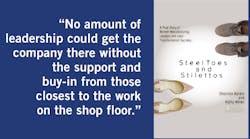In the course of transforming their business, Shannon Karels and Kathy Miller formed a deep friendship. Their book, Steel Toes and Stilettos: A True Story of Women Manufacturing Leaders and Lean Transformation Success tells the story of their friendship and their journey as leaders in industry.
Looking for other great content to read? Reliable Reading will review stellar books on the maintenance and reliability industry, leadership and management practices, and anything that relates to professionals in our industry.
The two friends first joined forces professionally, when Miller hired Karels to be a part of her divisional leadership team at a $75 million operation with four facilities in two countries. The book detailed how they transformed a traditionally run batch operation to a Lean enterprise. The story is not just about amazing business results, though they did achieve that, it’s also about how authentic leadership and an inclusive culture made those business results possible.
The following are my major takeaways from the book, but don’t stop here, this is just part of what you can learn from the full text.
The value of spending time on the shop floor
At the start of the journey, with her strategic team in place, Miller knew she had about 18 months to not only build a new foundation and establish a new Lean vision for the team but also start achieving real results. In order to build trust and gain the respect of the team, Miller and Karels spent a lot of time with the team on the shop floor. They needed that time to both evaluate the operation and get to know the operators. “We would quickly learn about the importance of understanding one’s current state and the value of transparency,” they write.
In the early days of the transformation, Miller and her other leaders spent even more time on the shop floor, establishing processes and principles. “It was also time to enforce some basic housekeeping principles throughout the plant, establishing a place for everything and everything in its place. It was a way of creating an environment that was respectful to the people who spent most of their waking hours there,” Miller says.
The leadership team had a lot of work ahead of them to get where they wanted to go, but no amount of leadership could get the company there without the support and buy-in from those closest to the work on the shop floor. Material flow was a value stream tackled early on in the transformation. It was much needed at the plant, and it was where their efforts would significantly impact business performance measurements. The purchasing team worked hard to stabilize and standardize inventory, but the biggest changes came in how that material moved around the plant. At the time, operators left their machines to get their parts and take their finished parts to the next process. Supervisors and group leaders also had a “hot list” of materials they were chasing down for operators. Neither was an efficient use of time. Instead, they created a new position to run the material delivery routes via a two-tiered pushcart. “It was a very clunky process at first. Our ‘driver’ manually created his list of which machines needed what materials,” they write. “He was the one figuring out how to be efficient. Since he was becoming intimately involved in the process, he gave us the most ideas on the best way to deliver the material. Involve and empower those closest to the work, and you will go much faster.”
Work and fun are not mutually exclusive
Very early on, Miller clearly communicated her leadership values and expectations for her leadership team. Those values included a strong focus on Current and Future State, with the expectation that you “cannot overcommunicate” and will establish “a shared vision of what good looks like.” Secondly, work as a team, with “no walls,” “no victim mentality,” and “trust and respect.” And finally, work hard, but “have fun” and make sure to find “work-life balance.” The team had an incredible amount of work ahead of them, but “I did not consider that a mutually exclusive concept from having fun,” Miller says. “I believe in taking your job seriously, but yourself not so much.”
How authentic leadership can help drive business results
A good leader is an organized leader
How to utilize checklists to improve your maintenance program
Once the hard work is done, it’s also important to celebrate the successes. For Miller’s team, she is a big fan of creating traditions or celebrations. “Celebrations make space for all that nourishes our souls, our accomplishments, a pause from the ride, and a moment of gratitude. Celebrations bring affirmations, create memories, and allow us to see our teammates in a new light,” Miller says. Traditions or celebrations also do not need to be elaborate or expensive. She was a big fan of annual holiday party at her house, and birthday cards with meaningful notes of appreciation.
When in doubt, speak in three-letter acronyms
One of the first changes Miller made at the plant was to clean and paint the walls and ceiling. “It was time that the physical appearances of our facility reflected the excellence we strived to achieve,” Miller says. At her first presentation of divisional performance results, she knew she would be asked about the $40K facility expense. When the frugal group asked the inevitable question, Miller said it was for the E7P project. “Everybody nodded as though they knew what the E7P project was,” Miller said. “If it was worthy of a three-letter acronym, surely everyone should know what it was.” A colleague asked following the meeting, and she told him what E7P stood for: Eliminate 70s Paneling. “Not generally a risk-taker, more of a rule-follower, I had gotten away with it. Under normal circumstances, I would have asked permission and most likely been denied spending the money. I learned an important lesson that day: when in doubt, speak in three-letter acronyms. It helps you exude confidence,” Miller says.
Foster a culture of inclusivity
As a new member of the team, Karels had to work doubly hard to gain trust and respect. Also, most teams will have a general skepticism for new programs and initiatives. They had seen other improvements that didn’t stick and other plans that never became foundational change. It was a tall order to get them onboard. “I was starting to realize that implementing the tools wasn’t going to be the hard part. It was navigating through the team’s varied emotions and prolific opinions that would end up taking most of my energy,” Karels says.
After sending out a task list and learning a few weeks later that the implementation team had not reviewed it, let along taken any action, Karels “learned the power of regular touchpoints and a weekly cadence for updates.” In addition to communicating and updating her team more regularly, she also involved them more closely in the process. Particularly for task completion, Karels found more success when she would document high-level, significant actions, then work with the team to break them down into individual steps. She was also learning that not everyone is motivated in the same way. “I decided to get more personally involved with each team member in their actions. ‘How can I help? Let’s talk through it’,” Karels says.
Carry a big bottle of ibuprofen
Team members all need feedback and constructive criticism in different ways and figuring that out is part of being a leader. Miller believes in positive feedback and coaching, but not false flattery, dishonesty, or anonymous feedback. Sometimes feedback and coaching is heavy and emotion, but not always. “When someone is blowing off steam and needs to be heard about something, a reminder to keep a big bottle of ibuprofen around at all times would be utterly appropriate feedback. It is a critical piece of personal protective equipment needed in operations, and sometimes that reminder is needed. This particular line of feedback was offered in the spirit of, ‘I feel your pain. I have been there. Now shake it off and get back out there!’ If I haven’t mentioned it yet, let me say it right now: a manufacturing career is not for the faint of heart,” Miller says.
When everything is important, nothing is important
A comprehensive strategy comes later in the process, but once the vision and the value have been established, it’s time to focus on the key priorities. They had done the work with many tools, including a Strategy Deployment (SD) process, another name for the PDCA process to align the organization around specific actions. Every division had their own strategy deployment matrix, and now the hard work needed to be done to combine them and choose priorities. “If done correctly, the company’s top leadership examines the environment in which it operates and the levels of performance it wants/needs to achieve to be successful in its markets. As a collective team, it establishes its annual improvement priorities, which are customer-focused, are multi-year, are multi-functional, are process-oriented, and will result in new ways of doing business,” Miller says. The tricky part is to not have too many goals—to prioritize. “When everything is important, then nothing is important,” she adds.
This story originally appeared in the April 2022 issue of Plant Services. Subscribe to Plant Services here.


